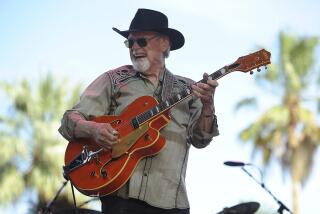Al Casey, 89; Guitarist in Fats Waller Band
- Share via
Al Casey, a guitarist who joined Fats Waller’s band in high school and provided a steady and swinging rhythmic accompaniment for the leader’s vocal antics, died Sept. 11 at a nursing home in New York City. He was 89 and had colon cancer.
Casey’s association with Waller lasted from 1933 until the pianist, singer and composer’s death a decade later. However overshadowed he might have been by Waller’s dynamic piano style and flirtatious ad-libbing, Casey said he was hired to keep the band tight during Waller’s fun yelps and scats. The guitarist appeared on more than 230 records that sold millions of copies.
French critic Hugues Panassie, a follower of the early American jazz scene, once wrote that Casey “developed a distinctive manner of accompanying vocal choruses with chords that formed a beautiful counterpoint.”
Casey stayed through many incarnations of the Waller band. His most notable contribution to a recording was his bluesy and sublime solo on “Buck Jumpin’ ” (1941), a song that originated as a punishment for being late to a performance date. Casey came onstage while the band was playing, and Waller made him solo spontaneously to a blues number, hoping he would flail and learn his lesson.
The tune was so successful that it became Casey’s unofficial anthem.
Albert Aloysius Casey was born Sept. 15, 1915, in Louisville, Ky. An orphan, he gained a new family that included uncles and aunts who were in a spiritual group called the Southern Singers. One of those uncles, featured on a radio show broadcast from Cincinnati, provided the key introduction to Waller years later.
Moving to New York City in 1930 to stay with other relatives, Casey began playing guitar with a school friend’s band, which played at Harlem’s Apollo Theater and other venues. Advanced enough for his uncle to encourage a meeting with Waller, he impressed the bandleader and began recording songs.
However, Waller refused to hire Casey full time until he finished high school. The guitarist later called Waller his “second father.”
After some music school training, Casey developed a fast-moving style that jumped from chord to chord. This, he felt, would do justice to Waller’s vocal buffoonery, as he called it.
In the late 1930s, he left Waller temporarily to work with pianist Teddy Wilson and also made recordings with singer Billie Holiday and saxophonists Ben Webster, Chu Berry and Lester Young.
After Waller’s death from pneumonia, Casey readily accepted work as a New York-based sideman, at that point switching to electric guitar. He led the house trio at New York’s Downbeat Club, most of the time trying to imitate Nat King Cole’s small band and even attempting singing. Apparently he was passable enough to win Esquire magazine awards for best swing guitarist in 1944 and 1945. That led to gala concerts with Duke Ellington in California and Louis Armstrong in New York.
Other jobs brought Casey dates with pianist Art Tatum and saxophonist Coleman Hawkins, as well as bebop stars Charlie Parker and Dizzy Gillespie.
Casey struggled through several decades as swing fell from favor, at one point working for the New York City Health Department as a Xerox operator.
In the early 1980s, he began a 20-year association with the Harlem Blues and Jazz Band, established by a New York orthodontist named Albert Vollmer, who revered the jazz players of the 1930s. Casey liked to point out that he was the youngest member of the group, which featured veterans of bands led by Armstrong, Ellington, Jelly Roll Morton and King Oliver.
Highly regarded in Europe -- he met jazz aficionados who had an encyclopedic knowledge of his recording history -- Casey remained largely overlooked in the United States. Survivors include his wife of 67 years, Althea Jonathan Casey of New York; and a son, Al Casey Jr. of Las Vegas.
More to Read
The biggest entertainment stories
Get our big stories about Hollywood, film, television, music, arts, culture and more right in your inbox as soon as they publish.
You may occasionally receive promotional content from the Los Angeles Times.










